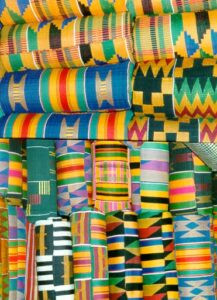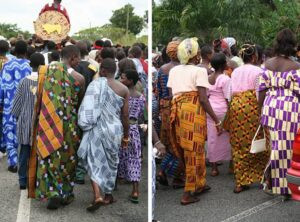
Fashion Kente Fabric (GHANA)
The country of Ghana, officially known as the Republic of Ghana, is situated along the Gulf of Guinea and the Atlantic Ocean in the West African sub-region. Ghana shares borders with the Ivory Coast to the west, Burkina Faso to the north, Togo to the east, and the Gulf of Guinea and Atlantic Ocean to the south. The term “Ghana” translates to “Warrior King” in the Mande language.
The territory of present-day Ghana has been inhabited for millennia, dating back to 6000 B.C., with the first permanent state established in the 11th century. Over the centuries, numerous kingdoms and empires emerged, with the Kingdom of Ashanti being the most powerful.

In 1471, the Portuguese were the first Europeans to explore modern-day Ghana. While initially searching for a sea route to the Far East, they began building forts along the coast, engaging in trade with inland tribes for gold. By 1600, the Dutch and English joined the exploration, followed by the Germans and Danes, all seeking ivory and gold. The trade involved exchanging rum, cotton, cloth, beads, and weapons with the tribes.
Eventually, Europeans forcibly captured Ghanaians as slaves, with the British establishing control of the coast by the late 19th century. By the mid-1800s, in addition to ivory and gold, Ghana was exporting palm oil, pepper, and corn.
To boost economic development, the government distributed cocoa beans to local farmers, encouraging the growth of the cocoa industry. After over a century of native resistance, Ghana’s current borders were established by the 1900s under British rule. In 1957, it became the first sub-Saharan African nation to declare independence from European colonization and was renamed Ghana.
Among the Asante (or Ashanti) people of Ghana, a popular legend tells of two young men—Ota Karaban and Kwaku Ameyaw—who learned the art of weaving by observing a spider. The spider, named Ananse, showed them how to weave intricate designs in exchange for favors. The men introduced their creation, kente, to the Asante kingdom, and adopted it as a royal cloth for special occasions.

Men (left) and women (right) wearing KENTE
Originally reserved for Asante royalty, kente is associated with wealth, social status, and cultural sophistication. Historians believe kente cloth originated from weaving traditions in West Africa and incorporated materials like French and Italian silk. The Ewe people also adopted kente production from the Asante, adding their variations.
Kente is woven on a horizontal strip loom, creating narrow bands of cloth. Weaving involves crossing warp (vertical) and weft (horizontal) threads to produce intricate patterns valued for their visual effect and symbolism. Each pattern and cloth has a name inspired by history, proverbs, philosophy, or cultural values.
Men and women wear kente differently, with variations based on age, marital status, and social standing. Modern changes have made kente accessible to more people, no longer restricted to royalty. The cloth is now cut and sewn into various forms, including dresses, shirts, and shoes. Despite these changes, kente remains an iconic representation of West Africa’s history, philosophy, and cultural heritage, symbolizing pride and nobility throughout the African diaspora.
